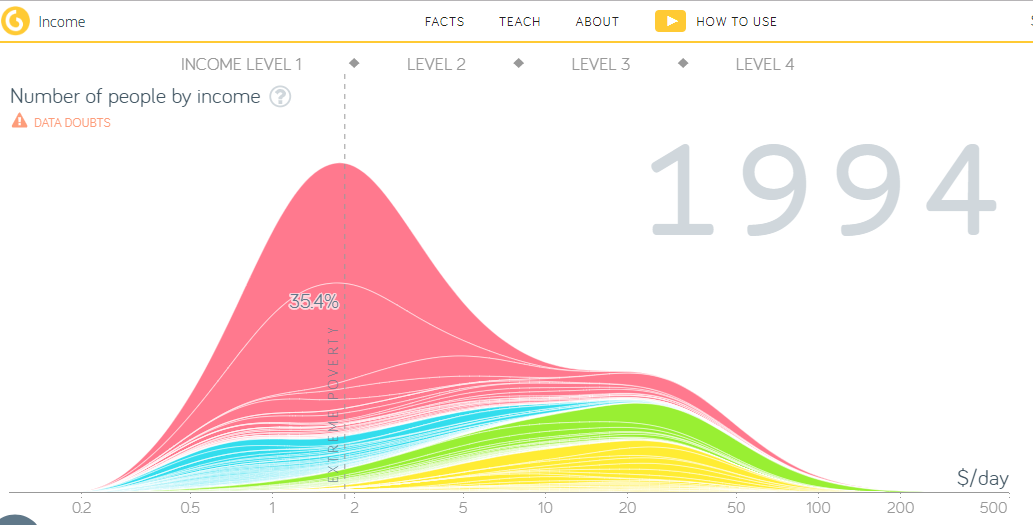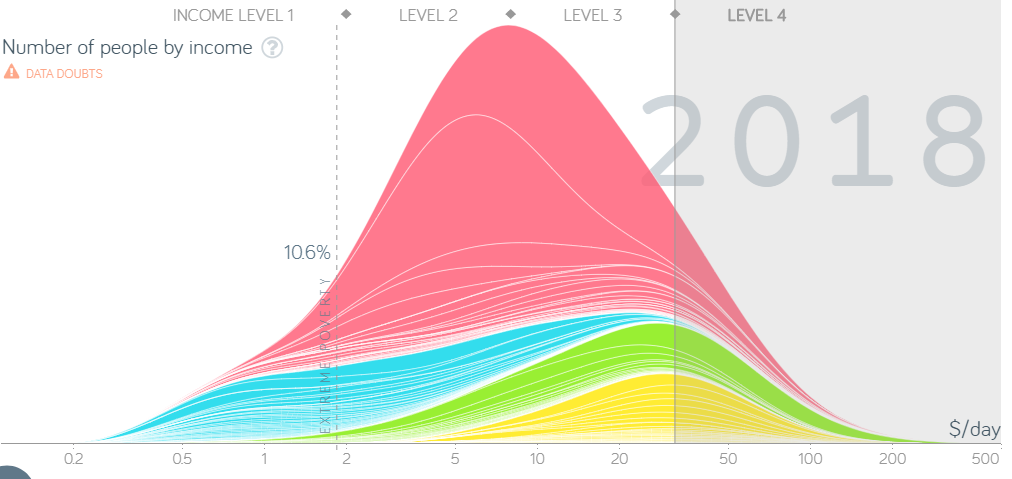Many of you have probably seen Hans Rosling’s famous TED talk where he describes 200+ years of economic history using animated bubble charts and a very big stick. See below.
Factfulness is the book. Factfulness: 10 Reasons We’re Wrong About the World, Hans Rosling, Ola Rosling, Anna Rosling Ronnnlund (affiliate link). Super-enjoyed it. Simply-written, thought-provoking, educational, and fact-based.
“We need to learn to control our drama intake”
Do me a favor at go to Gapminder and take the 13 question quiz here. Don’t be ashamed, I got 30% right when I took it, less than a chimpanzee. Yes, we have a dramatically and negatively bias view of the world. Clearly, we need to have a more fact-based worldview, and the Bill Gates quote on the cover sums it up, “One of the most important books I’ve ever read – an indispensable guide to thinking clearly about the world.”
“Divide it [world] into four income levels.”
Too often, we mentally divide the world into “us” and “them”. In the US, it might be developed, or industrialized countries (a.k.a. the North) vs. the ones developing (a.k.a. the South). Rosling argues that a better way to describe the income distribution is into 4 buckets. <$2 per day/person, $2-8, $8-32, and $32 per day/person.
Some reasons to be grateful:
- If you are reading this blog (>$12K/year) you’re probably level 4. This is the richest 1/7 of the world.
- In 1800, 85% of the world’s population was at level 1.
- In 1800, British children started work at the age of 10, because they have to feed themselves.
See the two graphs below, comparing 1994 vs. 2018 income distribution from their website here.
1994: This was only 25 years ago, and yet 35%+ of the world’s population in extreme poverty, less than $2/day.

2018 – Fast forward 20+ years, the mean per capita income has shifted dramatically to the right. Only 10%+ of people are living in extreme poverty now. Massive improvement.

DollarStreet: Imagine the world as a street ordered by income
The way that we live is surprisingly similar. They have a photo collage of how people live across the world, at different income levels. Here is what $3K-4K looks like around the world here. Spoiler alert – it doesn’t matter if you live in the Ukraine, France, India, Sweden. Kinda the same. Net/net: we need to stop stereotyping and vilifying people who are not like ourselves.
“Population will top off at ~ 11 billion”
Where is population headed?
Global population in 1800 was 1 billion. At the time, Malthus predicted the world would run out of food. Wrong on two counts: 1) agriculture productivity (think: fertilizers, seeds, tractors) 2) fewer babies per family (think: smaller families with higher income). See the spike below. Population growth went from 1 to 7 billion in 220 years (Wha? That looks like a growth stock, right?) Forecasts show that it will likely level off at 11 billion. Either way, Malthus is still wrong. See the video here.

Practice Factfulness
As logical as we think we are [homo economicus), we are pretty emotional, biased, lizard-brain-driven people. So, it’s important that we actually practice factfulness. As management consultants, we get paid because of our structured thinking and the rigor we apply to data. Basically, we get paid to be factful. A few of the many great tips in the book:
1. Beware of averages and extremes
Yes. I tell this to students and junior consultants all the time. “Average is a 4-letter word”. Averages can be massively misleading, so be smart and nuanced when you are describing a distribution.
Yes, be careful of extremes. 24hr news cycles focus on shark attacks, random violence, and other rare things to capture our attention. The don’t announce every successful plane arrival and takeoff.
So what? a) Include standard deviation when you show the average b) If you take outliers from the data set, document what you took out, and why c) Always keep a back-up copy of the original, raw data,
2. Distinguish between the level (bad), and the direction (better)
Yes, what’s the trend? If net margin is 2%, is that good / bad, getting better or worse. As one of my professors used to say, “point estimates are for suckers.”
So what? a) If it is a new process or business, look at the leading indicators. Look at the direction, not just the level. Companies often evaluate a new venture with the same metrics as they use for established businesses. Dumb. b) Look for inflection points, changes in direction c) Look at the rate of acceleration/deceleration. Think calculus.
3. Get things in proportion
A random number (e.g., $57 million in SG&A costs) does not mean anything without context. You need to understand the magnitude of the problem or the fix.
So what? a) Compare the # to something (an external or internal benchmark) to evaluate it’s relative value b) Divide the number by something else. For example, $7M in customer acquisition costs. . .is that a lot or not a lot? I don’t know. How many customers did you get? c) Think orders of magnitude. Is this a $100K or $1M or $10M solution? d) Continuously drive to a 80/20 principle. What are the inputs that are driving the majority of the outputs?
4. Slow change is still change
I forget this all the time.
So what? a) Clients hire consultants to get results. Document progress b) Manage up and get the client executives on the hook to break down barriers and own some of the change c) Create a governance drum beat of report-outs; hold people’s feet to the fire d) Celebrate the small wins / changes you make d) Insist on getting the data.
5. Get a toolbox, not a hammer
It’s easy to fall into a single (namely, my) perspective.
So what? a) Create an approach to the problem, which outlines HOW you will get to the answer, and hold yourself accountable to the process. Do the work. Don’t fast-track to the answer you already think. b) Use “red-team” to stress test your assumptions. Better that you kick-around your recommendation BEFORE the client does c) Look for best practices, innovation, use-cases from OUTSIDE the industry d) Numbers are important, but they are not everything. Quantitative + Qualitative. e) “Beware of simple ideas, and simple solutions.” They are probably wrong.
6. Resist finding the scapegoat
Wow, this is deep. Yes, I believe that a lot of what ails modern society is the effort to place blame on someone other than ourselves. Read: Extreme Ownership, Jocko Willink (affiliate link). Rosling wisely advises:
- Look for the root-cause, not the villain
- Look for systems, not heroes
So what? a) Yes, people are messy and the client is not perfect. As a previous manager of mine often said, “no one comes to work planning to do a bad job.” b) When crafting organizational design, focus the tasks and activities, not just putting “heroes” in boxes c) Often there are many root causes, and dependencies; it’s not a simple one-cut-Gordian-knot answer.
Bonus video, 200 countries, 200 years, 4 minutes
If you did not watch the TED talk above, definitely invest 4 minutes here. As consultants, we pride ourselves on visually representing complex data simply. Watch the master.
How did you score on the Gapminder quiz?
Gapminder 13 question quiz here. Put your scores in the comment box. I got a 30%.
DB – thanks for the book recommendation.

This is a great blog about a fantastic book – and my biggest take-away is that things are never as bad as we think they are, and a continuous desire to improve is a true-north value that all of us should strive to achieve.
True, true.
This is a great article. Thank your sharing. It would be great if the politician read it. It would certainly reduce the political discourse in America. Many speak without knowing the facts or using incorrect facts to present their view point.
Completely agree. US election year, and it’s a mess. 90% of what is being said, makes no economic sense. We have to do our best – locally.
77
77 is amazing. . .better that most of the world.
69%.
But as your blog post is about Gosling I was a bit biased when selecting the answers…
Absolutely, if you choose all the most positive answers, I imagine you would do well.